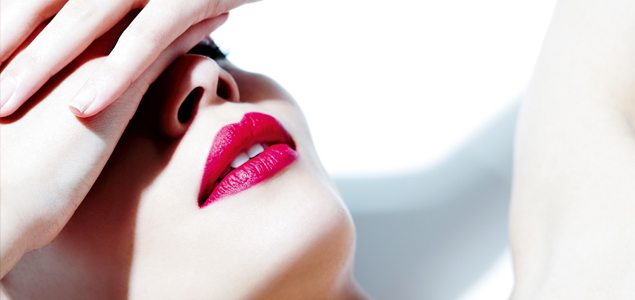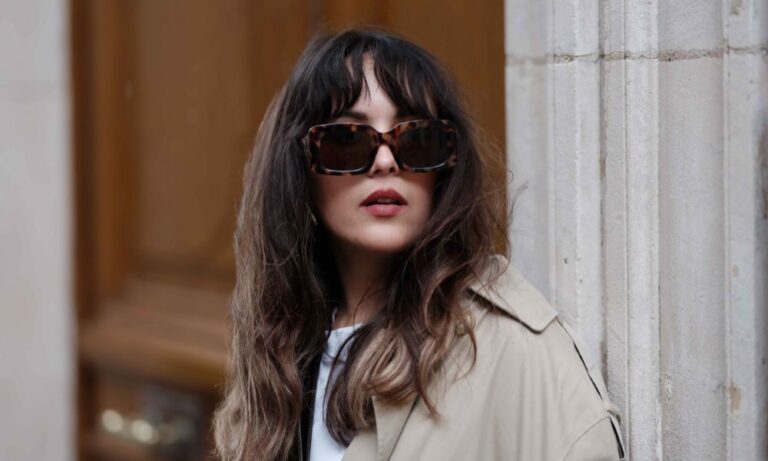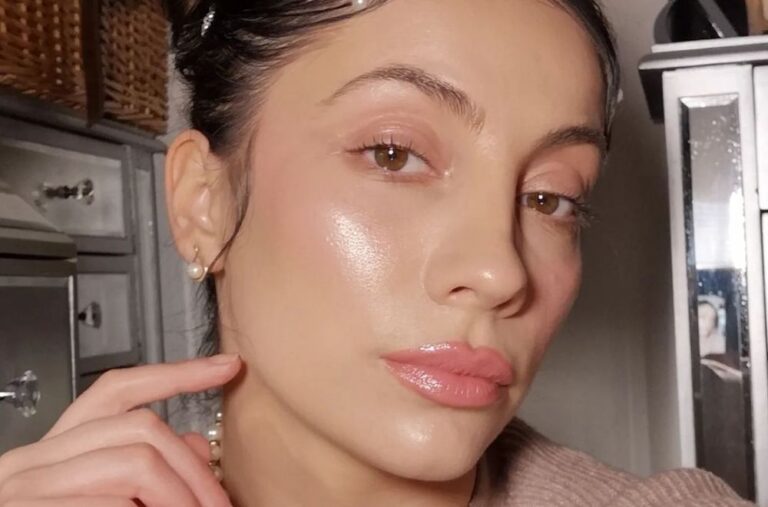Think your lipstick is just a tool to make you look good? Guess again. There is no other beauty product in your bathroom that carries as much historical, sexual, economic, social, political or cultural baggage, as your lipstick.
Slick on a lick of red to boost your boardroom confidence and you’re evoking the ghosts of Cleopatra and Queen Elizabeth I. Daub your lips with a high-gloss and you’re suggesting a state of arousal that silent movie actresses used to achieve by licking their lips as the camera rolled. Go without may find yourself in the company of 18th century puritanical thinking, early feminists and the numerous women who have faced disciplinary action over their use of cosmetics in the workplace. Such are the many subtexts as we paint our lips.
“Historically the trends for what’s attractive on women have changed drastically,” says cosmetic historian Rachel Weingarten, author of Hello Gorgeous! Beauty Products in America ‘40s-‘60s (Collectors Press). “But lips have always been seen as the thing that finishes the face. I believe it’s that final veneer and top accessory of power that says, this is where I am.”
Face facts
Lipstick is typically made from a combination of pigments, oils, fats, emulsifiers and waxes – the latter helps it to keep its solid form. Maurice Levy is credited as creating the metal lipstick tube in 1915, which featured a lever to raise and lower the bullet of colour. The first swivel-up tube came in 1923, created by American inventor James Bruce Mason Jr.
Tubes of lipstick are the number one cosmetic seller globally, outnumbering sales of other make-up products by approximately four to one and approximately 75-85 per cent of all American women wear lipstick according to Jessica Pallingston, author of Lipstick: A Celebration of the World’s Favourite Cosmetic (St Martin’s Press). Global analysis agency The NPD Group put the value of prestige lip product sales in US department stores at US$185.2 million (A$204 million) in 2011. “Coming out of the recession, it seems that the consumers’ thirst for colour and play was reawakened,” says Karen Grant, vice president and senior global industry analyst at The NPD Group.
Cosmetic supremo Leonard Lauder coined the term “lipstick index” after US lipstick sales increased by 11 per cent during the 2001 recession. Similarly, during the Great Depression, cosmetic sales increased by 25 per cent. The “lipstick index” theory goes that consumers exchange spending on big luxuries in favour of smaller ones in times of economic stress, lipstick being a prime example of a small luxury. According to The Economist however, historical figures don’t always hold true to the theory, particularly during the most recent recession which saw lipstick sales drop.
A painted history
One thing is for certain – lipstick’s tremendous influence on the modern cultural landscape. Twentieth-century pop culture is awash with references to the cosmetic. Bright red lipstick put the cherry on top of Marilyn Monroe’s sex appeal and Salvador Dali paid homage to another silver screen star with his sensual Mae West lip sofa. Think of The Rolling Stones and you immediately picture their iconic swollen red tongue and lips logo (Mick often experimented with cosmetics).
In the 1980s, punks used black or purple lips to underline the anarchy of their words, songs and fashion stance. Lady Gaga often subverts her look with lipstick, wearing everything from metallic blue to black, make-up that is as experimental as her fashion choices. Each season, the lip is one of the key mediums that fashion designers and make-up artists use to convey the message of their collection, be it nude and natural, bright and playful, glossy and sexy or dark and edgy. “Lipstick is the ultimate tool (or weapon),” says Lloyd Simmonds, creative director of make-up at Yves Saint Laurent.
Yet lipstick is far from being a modern invention. According to Read My Lips: A Cultural History of Lipstick by Meg Cohen Ragas and Karen Kozlowski (Chronicle Books), cases of lipstick were discovered in a 5000-year-old tomb in Sumeria (in modern-day Iraq), and an ancient Egyptian scroll shows a woman painting her lips. “Lipstick was historically one of the first tools women had to enhance their beauty,” explains Weingarten. “Maybe also pinching the cheeks and using kohl on eyes, but lips were easy and made a statement.”
Cleopatra was famed for her heavily kohled eyes and red lips – the latter created from crushed beetles and ants. After a period when the Christian church denigrated painted lips, Queen Elizabeth I made red lips popular again among the upper classes. In her book Lipstick, Jessica Pallingston describes Queen Elizabeth’s lipstick routine: “Put on lip dye and cover with a glaze of egg white… For chapped lips, take some sweat from behind your ears and rub onto mouth.”
Puritanical thinking in much of Europe and the United States in the 1700s equated cosmetics with witchcraft and prostitutes. A British law declared that women who seduced men into matrimony using lip or cheek paints could have their marriage annulled and face charges of witchcraft and a 1915 Kansas bill attempted to make it a misdemeanour for women under 44 to wear make-up “if for the purpose of creating a false impression.”
At the turn of last century, the advent of the silver screen and its heroines prompted a lipstick resurgence when the likes of Max Factor began creating products for actresses, which then filtered down to the public. The late 1800s and early 1900s saw the commercialisation of lipstick with the emergence of brands such as Guerlain, Max Factor, Estee Lauder, Elizabeth Arden and Shiseido, who created their first lip rouge (Beni in Japanese) in 1922. Coco Chanel introduced her own red lipstick in 1924, favouring a deep vermilion. “The eyes are the windows to the soul, why not also admit that the lips are the mouthpiece of the heart?” she is quoted as saying.
More recently, many contemporary cosmetics brands see lipstick as their defining product. “Russian Red, Twig, Chelsea and Taupe are the names that created a buzz about M.A.C in the 90s. They were the hippest lipsticks to wear,” says Gordon Espinet, vice president of make-up artistry at M.A.C. “Lipstick was what got the make-up artists and celebrities lining up to try the new make-up and this category continues to be a big part of our appeal.” M.A.C’s iconic Viva Glam lipstick, which collaborates with celebrities, is the spearhead for the company’s Aids Fund.
Painted lips cross cultures and genders. Throughout history it has been common for men to wear lipstick and in the Japanese Edo period it was used for celebrations, according to Shiseido. Black-stained lips are part of the ceremonial body art of the men of the Wodaabe people in West Africa. Closer to home, Maori moko permanent body marking often centres on the lips and chin.
Lip lore
Since the first prehistoric woman potentially kick-started a frenzy of lust from male homo sapiens by chowing down on a bunch of berries or something similar that stained her lips, the success of lipstick was sealed. Anthropologically, writers such as Diane Ackerman, author of A Natural History of the Senses (Vintage), claim that red lips remind men of a woman’s labia when aroused, particularly when also glossy. Others argue they conjure youthfulness, as children’s lips are naturally redder than adults’.
“There’s so much tied into lips, the sexuality, the kissing, the hint,” says Weingarten. “Scientists claim that enhancing lips makes men think of a woman’s nether regions. I think it’s just so easy to
feel sexy and stylish with lipstick. It’s the easiest statement to make and it’s smack in the middle of your face.”
The question is, what statement does enhancing the lips make in modern Western society? Little girls often don lipstick when playing mummy. The word “lipstick” is used as an adjective in incongruous ways: “lipstick rebels,” “lipstick lesbians” and “lipstick bounty hunters” (yes, really). There have been numerous cases of corporations taking disciplinary action against staff over lipstick shades worn – or not worn.
A recent incident involved Turkish Airlines, which released a statement saying that flight attendants were banned from wearing red, dark pink and similar shades of lipstick. According to CNN, Turkish female activists responded by bombing social media with defiant images of themselves in red and bright pink lipstick. The statement was later retracted.
Author and social critic Naomi Wolf argued against the concentration on a woman’s appearance over her professional skills in her bestselling book The Beauty Myth, and asked: “Does all this mean we can’t wear lipstick without feeling guilty?”
But other theorists claim lipstick as a post-feminist tool of power. They may be right, in a roundabout way. A recent study by Harvard University’s psychology department, which was funded by Procter & Gamble (its brands include CoverGirl and Dolce & Gabbana cosmetics), found that women wearing more make-up are judged to be more competent.
“Where is lipstick something that belongs to the people looking at it, and where is it something that belongs to you?” asks Weingarten. It’s an interesting question. Because if you think you live in a free, modern society where anyone can wear what they want, try applying a bright blue or green lipstick for your next meeting or school run and see what sort of reaction you get from others.
We may have crossed most lines today when it comes to shock and sartorial envelope-pushing, but the image of Hilary Clinton attending the UN with electric orange lips would have the power to
Lip tips
Lip colour decreases with age, which is why pale shades tend to work better for younger women and brighter shades suit those over 40.
In her book Bobbi Brown Beauty Evolution (HarperCollins), Bobbi Brown advises: “Own a beige lipstick and a sheer blackberry to help fix mistakes. The beige will tone down a too-bright shade; blackberry will deepen any lipstick and turn it into a great evening colour.”
To test lipstick shades before buying, apply to the pads of your fingertips where the skin tone is close to that of your lips.
Lipliner becomes more useful the older you get, as it helps to stop your lipstick “bleeding” into lines around the mouth.
In The Anti-Ageing Beauty Bible (Kyle Cathie) by Josephine Fairley and Sarah Stacey, British make-up artist Barbara Daly advises women aged 45 to 60 to steer clear of dominating red lipstick. “After 60 you can take it up again – it becomes a glamorous ‘statement’, a bit eccentric and rather divine.”
Tips can be helpful, but don’t let them rule you. “If you love a shade you will be able to pull it off, always give it a go,” says Amber D, M.A.C’s Senior Artist for Oceania. “It’s just make-up, it washes off.”
Eat me
Early lip products may have contained crushed beetles, lead and toxic bromine, but preliminary research by the University of California Berkeley’s School of Public Health suggests modern lipsticks could be just as damaging.
Metals such as cadmium, aluminium and chromium are commonly found in lip products and raise health risks. It’s long been stated, and debunked, and stated again that women consume an alarming quantity of lipstick in their lifetime.
In The 21st Century Beauty Bible, Aveda founder Horst Rechelbacher puts the amount at “one-and-a-half to four tubes of lipstick”.
Thankfully there are many lipsticks available for today’s natural beauty consumers:
• Bite Beauty’s lipstick tastes delicious, thanks to the liberal use of food grade ingredients and natural fruit butters. The company’s Luminous Crème Lipstick contains antioxidant-rich resveratrol from red wine grapes, ($36.95, +64 9528 5653).
• INIKA’s lipsticks are certified organic, vegan and have great colour pigmentation. The newest shade is Coral, an orangey pink. ($36.50, Inikacosmetics.co.nz).
• Karen Murrell lipsticks are made with organic and non-toxic ingredients. Twin packs available from theiconic.com.au, $56.95.
• NVEY Eco’s lipsticks are completely chemical-free, and their Advanced Care Lip Colour contains nourishing ingredients like vitamin E and shea butter, ($29.95, Nveymakeup.com).







